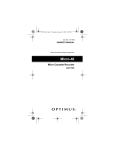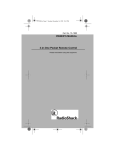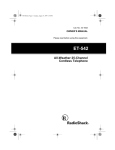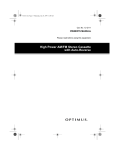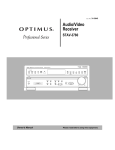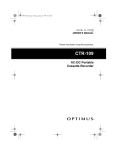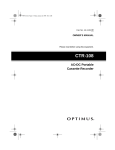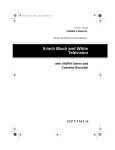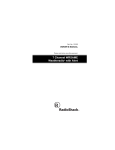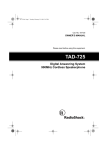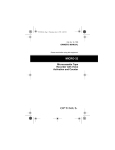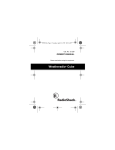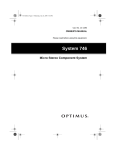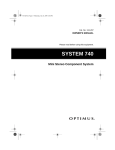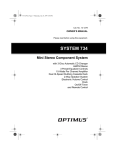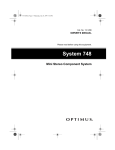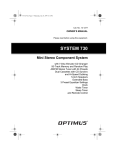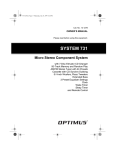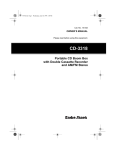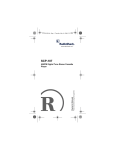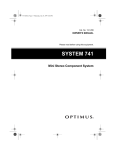Download Optimus 14-546A CD Player User Manual
Transcript
14-546a.fm Page 1 Wednesday, April 7, 1999 6:57 AM Cat. No. 14-546A B OWNER’S MANUAL Please read before using this equipment. CD-3321 Portable Triple-Play Compact Disc Player with AM/FM Stereo Dual-Cassette Recorder 14-546a.fm Page 2 Wednesday, April 7, 1999 6:57 AM FEATURES Your Optimus CD-3321 Portable TriplePlay Compact Disc Player combines a CD player, an AM/FM radio, and a double cassette player with detachable speakers — all in one convenient, portable package. CD Player Features Programmable Play — lets you program up to 21 tracks to play in any sequence. Audible Search — helps you locate a particular section of a track by playing the CD rapidly in either direction. Automatic Search Music System (ASMS) — quickly locates and plays any track on a CD. Repeat Play — lets you automatically repeat a single track, an entire CD, or a series of programmed tracks. Other Special Features E-Bass Control — boosts low tones for an emphasized bass sound. Three Power Options — lets you power the CD-3321 from internal batteries (not supplied), standard AC power (with the supplied AC power cord), or your vehicle’s cigarette-lighter socket (with an optional adapter). WARNING: To reduce the risk of fire or shock hazard, do not expose this product to rain or moisture. CAUTION RISK OF ELECTRIC SHOCK. DO NOT OPEN. CAUTION: TO REDUCE THE RISK OF ELECTRIC SHOCK, DO NOT REMOVE COVER OR BACK. NO USER-SERVICEABLE PARTS INSIDE. REFER SERVICING TO QUALIFIED PERSONNEL. This symbol is intended to alert you to the presence of uninsulated dangerous voltage within the product’s enclosure that might be of sufficient magnitude to constitute a risk of electric shock. Do not open the product’s case. Cassette Deck Features Multiple Source Recording — lets you record from the CD player, radio, or another cassette tape. Automatic Level Control (ALC) — automatically adjusts the recording level. ! This symbol is intended to inform you that important operating and maintenance instructions are included in the literature accompanying this product. © 1999 Tandy Corporation. All Rights Reserved. Optimus and RadioShack are registered trademarks used by Tandy Corporation. 2 ! 14-546a.fm Page 3 Wednesday, April 7, 1999 6:57 AM Warning: This system employs a laser light beam. Only a qualified service person should remove the cover or attempt to service this device, due to possible eye injury. CDs that can be played on this player have this mark on them: Note: Most material on compact discs and prerecorded tapes is copyrighted. Unauthorized duplication of copyrighted material is a violation of the copyright laws of most countries and such duplication may result in fines and/or imprisonment. Note, however, that in the United States, it is not a violation of U.S. copyright laws for a consumer to use an audio recording device to duplicate musical recordings for noncommercial (personal) use. 3 14-546a.fm Page 4 Wednesday, April 7, 1999 6:57 AM CONTENTS Preparation .............................................................................................................. Connecting the Speakers ................................................................................... Connecting Power .............................................................................................. Using Batteries ............................................................................................. Using AC Power ........................................................................................... Using Your Vehicle’s Cigarette-Lighter Socket ............................................. Using Headphones ............................................................................................. Listening Safely ............................................................................................ 5 5 6 6 7 7 8 8 Using the Radio ....................................................................................................... 9 Using the CD Player .............................................................................................. Loading and Playing a CD ................................................................................ Special Features ............................................................................................... Pause ......................................................................................................... Cue ............................................................................................................ Repeat ....................................................................................................... Audible Search ........................................................................................... Automatic Search Music System (ASMS) .................................................. Programmed Play ............................................................................................. CD and CD Player Care Tips ............................................................................ 10 10 11 11 11 11 11 12 12 13 Using the Cassette Player .................................................................................... Loading a Cassette Tape .................................................................................. Playing a Cassette Tape ................................................................................... Normal Play ................................................................................................ Consecutive Play ........................................................................................ Using Fast-Forward and Rewind ................................................................ Using Pause ............................................................................................... Recording ......................................................................................................... Recording from the CD Player ................................................................... Recording from the Radio .......................................................................... Dubbing a Cassette Tape ........................................................................... Tape Tips .......................................................................................................... Erasing a Cassette Tape ............................................................................ Preventing Accidental Erasure ................................................................... Restoring Tape Tension and Sound Quality ............................................... 15 15 15 15 16 16 17 17 17 18 18 19 19 19 20 Care and Maintenance .......................................................................................... 21 Cleaning the Tape-Handling Parts .................................................................... 22 FCC Notice ....................................................................................................... 22 Specifications ........................................................................................................ 23 4 14-546a.fm Page 5 Wednesday, April 7, 1999 6:57 AM PREPARATION CONNECTING THE SPEAKERS Caution: Do not plug in the power cord until you connect the speakers. Operating the CD-3321 without connected speakers could damage it. 2. Align the tracks on the side of the left speaker with the tracks on the left end of the main system and slide the speaker down until it clicks into place. illus The connecting wires for the CD-3321’s detachable speakers are rolled up in the recessed area at the back of each speaker. illus Follow these steps to connect the speakers to the system. Note: The right speaker has the tracks on its left side when viewed from the front. The left speaker has the tracks on its right side when viewed from the front. 1. Align the tracks on the side of the right speaker with the tracks on the right end of the main system and slide the speaker down until it clicks into place. illus 3. Unwind the wire from each speaker. 4. Press the pair of terminal tabs marked SPEAKERS 8Ω/+R– on the back of the CD-3321. Insert the right speaker’s red wire into the red (+) terminal and its black wire into the black (–) terminal. Then release the tabs. Caution: To avoid damaging your system and speakers, never let the speaker wires’ bare ends touch each other. 5. Repeat Step 3 to connect the left speaker’s wires to the terminals marked SPEAKERS 8Ω/–L+. To disconnect the speakers from the system, first disconnect the speaker wires from the CD-3321. Then push in the mounting tabs on the sides of the main system and slide the speakers upward along the tracks. 5 14-546a.fm Page 6 Wednesday, April 7, 1999 6:57 AM Follow these steps to install batteries. illus 1. Remove the battery compartment cover by pushing the cover’s two tabs in the direction of the arrows. illus CONNECTING POWER You can power your CD-3321 from any of three power sources: • internal batteries • standard AC power (with the supplied power cord) 2. Insert eight D batteries as indicated by the polarity symbols (+ and –) marked inside the battery compartment. • your vehicle’s cigarette-lighter socket (with an optional DC adapter) illus Note: Connecting the power cord or an optional DC adapter disconnects the internal batteries. Using Batteries You need eight D batteries (not supplied) to power the CD-3321. We recommend RadioShack alkaline batteries. Cautions: • Use only fresh batteries of the required size and recommended type. • Do not mix old and new batteries or different types of batteries. 6 3. Replace the cover. When the CD-3321 operates erratically or not at all, replace the batteries. Cautions: • Always remove old or weak batteries. Batteries can leak chemicals that can destroy electronic parts. • Dispose of old batteries promptly and properly. Do not burn or bury them. 14-546a.fm Page 7 Wednesday, April 7, 1999 6:57 AM Note: If you do not plan to use the system for several days, or if you plan to power the system using only AC or DC power, remove the batteries. Using AC Power To use AC power, plug the supplied power cord into the AC 120V 60Hz jack on the back of the CD-3321. Then plug the cord’s other end into a standard AC outlet. illus Note: The plug’s blades are polarized (one blade is wider than the other) and it fits only one way. If the plug will not fit easily, turn it over and try again. Do not force it. Caution: Always unplug the power cord from the AC outlet before you unplug it from the CD-3321. Using Your Vehicle’s CigaretteLighter Socket To power the CD-3321 from your vehicle’s cigarette-lighter socket, you need a DC adapter (not supplied), such as Cat. No. 270-1528. Cautions: • You must use a DC cigarette-lighter adapter that supplies 12 volts and delivers at least 1 amp. Its center tip must be set to positive, and its plug must correctly fit the CD-3321’s DC 12V jack. The recommended adapter meets these specifications. Using an adapter that does not meet these specifications could damage the CD-3321 or the adapter. • Unplug the adapter from your vehicle’s cigarette-lighter socket when you turn off the ignition. This prevents your vehicle’s battery from being drained if you leave the CD3321 on when you turn off the ignition. • Always plug the DC adapter into the CD-3321 before you plug it into your vehicle’s cigarette-lighter socket, and unplug the adapter from your vehicle’s cigarette-lighter socket before you unplug its barrel plug from the CD-3321. 7 14-546a.fm Page 8 Wednesday, April 7, 1999 6:57 AM Insert the DC adapter’s 5.5 outer diameter/2.1 inner diameter barrel plug into the DC 12V jack on the back of the CD3321, then plug the DC adapter into your vehicle’s cigarette-lighter socket. illus Note: If the CD-3321 does not operate when you turn it on, remove the DC adapter from your vehicle’s cigarettelighter socket and check the socket for debris. Also check the fuse in the adapter and your vehicle’s fuse block. USING HEADPHONES For private listening, plug a pair of optional headphones with a 1/8-inch plug into the PHONES jack. Your local RadioShack store has a wide selection of headphones. illus Listening Safely To protect your hearing, follow these guidelines when you use headphones. 8 • Set the volume to its lowest setting before you begin listening. After you begin listening, adjust the volume to a comfortable listening level. • Do not listen at extremely high volume levels. Extended high-volume listening can lead to permanent hearing loss. • Once you set the volume, do not increase it. Over time your ears adapt to the listening level, so a volume level that does not cause discomfort might still damage your hearing. 14-546a.fm Page 9 Wednesday, April 7, 1999 6:57 AM USING THE RADIO 1. Press POWER to turn on the system. The POWER indicator lights. illus stations, set BAND to FM. The sound is no longer in stereo, but reception should improve. 5. Adjust VOLUME to a comfortable listening level. illus 2. Set FUNCTION to TUNER. illus 3. Set BAND to AM, FM, or FM STEREO. illus 4. Adjust TUNING to the desired station. illus 6. To enhance the bass sound, press E-BASS. illus 7. Adjust BALANCE as needed. illus 8. To turn off the system, press POWER. The POWER indicator turns off. Notes: • When you set BAND to FM STEREO and the radio receives an FM station in stereo, the FM STEREO indicator lights. • To improve reception for weak FM 9 14-546a.fm Page 10 Wednesday, April 7, 1999 6:57 AM USING THE CD PLAYER LOADING AND PLAYING A CD 1. Press POWER to turn on the system. The POWER indicator lights. 2. Set FUNCTION to CD. 00 then dISC appears. illus 3. Press PUSH OPEN. The CD compartment opens. illus 4. Place a CD in the compartment with the label facing up. illus (show label) Note: Be sure the CD is securely in place in the tray. 10 5. Close the compartment door. After a few seconds, the CD’s total number of tracks and total playing time appear. illus 6. Press PLAY/PAUSE. The track number and the elapsed time of the current track appear. The CD then plays all the tracks in order. illus 7. Adjust VOLUME, E-BASS, and BALANCE as needed. 8. The CD stops automatically after it plays all the tracks. To stop the CD before the end of the last track, press STOP. illus 14-546a.fm Page 11 Wednesday, April 7, 1999 6:57 AM SPECIAL FEATURES Repeat Pause You can repeatedly play one track, a programmed sequence, or an entire CD (see “Programmed Play” on Page 12). You can pause a CD during play by pressing PLAY/PAUSE. appears and the CD stops playing. illus illus To resume play, press PLAY/PAUSE again. disappears and the CD plays. To repeat a single track, press REPEAT before or during play. REPEAT 1 appears. To repeat an entire CD or programmed sequence, press REPEAT twice before or during play. REPEAT ALL appears. Cue To select a track before you begin play | or while a CD is paused, press SKIP or | until the desired track number appears. Then press PLAY/PAUSE to play the track. To cancel repeat play, press REPEAT until REPEAT 1 or REPEAT ALL disappears. Audible Search illus To search forward on the CD, hold down SEARCH during play. As you hold down SEARCH , the CD rapidly advances and you hear the music or information at a faster speed and lower volume. Release SEARCH to resume normal play. illus 11 14-546a.fm Page 12 Wednesday, April 7, 1999 6:57 AM To search SEARCH SEARCH backward, hold down during play. Release to resume normal play. Automatic Search Music System (ASMS) You can use the automatic search music system to skip forward or backward through tracks on a CD or in a programmed sequence. illus PROGRAMMED PLAY You can program up to 21 tracks on a CD to play in any sequence. 1. Load a CD into the CD compartment and close the door. The display shows the CD’s total number of tracks and total playing time. illus 2. Press PROGRAM. MEMORY and 00 P:01 (the first memory location) appears. | to skip to During play, press SKIP the beginning of the next track. During play, press SKIP | during play to skip to the beginning of the current track. | or | Press SKIP additional times to skip forward or backward through additional tracks. Notes: • If you press SKIP | while the first track is playing, the first track replays. | while the last • Pressing SKIP track is playing has no effect. 12 illus | or | 3. Press SKIP to find the track you want to program into memory location 1. 4. Press PROGRAM again to program the track. The next memory location appears. 5. Repeat Steps 3 and 4 for each track you want to program. Notes: • If you program more than 21 tracks, you replace the first tracks programmed with the new ones. 14-546a.fm Page 13 Wednesday, April 7, 1999 6:57 AM • After programming a sequence of tracks, repeatedly press PROGRAM to review the tracks you have already programmed. • To edit the programmed sequence, repeatedly press PROGRAM until the desired memory location appears. Then press SKIP | or | to find the track you want and press PROGRAM to store the new track. PLAY/PAUSE. 6. Press PROGRAM appears and the CD player plays the tracks in the order you programmed. Although a CD is very durable, you should handle it with care. We recommend the following precautions. • Keep the CD in its protective case or sleeve when you are not playing it. • Keep the CD dry. A drop of moisture can act as a lens and affect the laser beam’s focus. If it gets wet, wipe the CD with a soft, dry cloth before playing it. • Do not write on either side of a CD, especially the non-label side. Notes: • Press STOP to stop playing the sequence. • Press CD AND CD PLAYER CARE TIPS STOP, PROGRAM, then to start playing the sequence again from the beginning. PLAY | and | • Use SKIP to move through the programmed sequence during play. 7. To clear the program memory, do any of the following: • Press STOP, then open the CD compartment door. • Press STOP, then set FUNCTION to a function other than CD. • Keep the CD clean. Handle the CD by its edge to avoid fingerprints and surface scratches, which can prevent the laser from accurately reading the CD. To clean the surface, use a CD Cleaner Kit (such as Cat. No. 42-226) or Scratch ’n Fix (Cat. No. 42-127). • Do not store CDs in high-temperature, high-humidity locations. If the CD-3321 is subjected to a sudden shock or jolt during play, the CD’s rotation speed might suddenly change, and the music might be briefly interrupted or the current track might start over. This is not a malfunction. • Press STOP, then POWER to turn off the system. 13 14-546a.fm Page 14 Wednesday, April 7, 1999 6:57 AM Cautions: • To avoid damaging the CD player, do not place anything but a CD in the CD compartment. • Remove any loaded CD from the CD player before moving the CD3321 to prevent damaging the CD. • Moving the CD player suddenly from a cold place to a warmer one can cause moisture to form on the pickup lens and disrupt operation. If this happens, wait about 2 hours for the moisture to evaporate before playing a CD. 14 14-546a.fm Page 15 Wednesday, April 7, 1999 6:57 AM USING THE CASSETTE PLAYER You can play your favorite cassette tapes and make recordings from the CD-3321’s CD player or radio, or another tape with the CD-3321’s cassette decks. 3. Load a cassette tape with the side you want to play facing you, the exposed tape edge down, and the full reel to the left. LOADING A CASSETTE TAPE Follow these steps to load a cassette tape in Tape 1 or Tape 2. 1. Take up any slack in the cassette tape by turning the hub with a pencil. If you do not remove excess slack, the tape might become tangled in the record/playback mechanism. Avoid touching the tape. illus illus 4. Close the compartment door. PLAYING A CASSETTE TAPE You can play a cassette tape in either Tape 1 or Tape 2, or you can load cassette tapes in both decks and play them consecutively. Normal Play 2. Press STOP/EJECT to open the cassette compartment door. illus Follow these steps to play a cassette tape in Tape 1 or Tape 2. 1. Load a cassette tape in Tape 1 or Tape 2. 2. Set FUNCTION to TAPE DUBBING NORM. illus 15 14-546a.fm Page 16 Wednesday, April 7, 1999 6:57 AM 3. Press POWER to turn on the system. The POWER indicator lights. illus Consecutive Play The CD-3321 can play one side of a tape in Tape 2, then automatically play one side of a tape in Tape 1. With tapes loaded in both Tape 1 and Tape 2, press PLAY on Tape 2, and press PAUSE then PLAY on Tape 1. 4. Press PLAY on the deck you are using. The button locks down and the tape begins to play. illus 5. Adjust VOLUME, E-BASS, and BALANCE as needed. 6. The tape automatically stops when it reaches the end. To stop playing the tape before it reaches the end, press STOP/EJECT. Press STOP/ EJECT again to open the cassette compartment, so you can remove the cassette tape. illus To play the other side, turn the tape over and press PLAY. 16 The tape in Tape 2 plays to the end of the first side. Then Tape 1’s tape plays to the end of its first side. Using Fast-Forward and Rewind While the tape is stopped or playing, press FAST-F or REWIND to move the tape rapidly forward or backward. Press STOP/EJECT when you reach the desired section or when the tape reaches the end. Illus of FAST-F/ REWIND 14-546a.fm Page 17 Wednesday, April 7, 1999 6:57 AM Using Pause Press PAUSE to temporarily stop play. Press PAUSE again to resume play. illus (arrow shouldn’t cover PLAY) • Before recording, be sure the eraseprotection tabs are in place on the cassette tape you are using to record. See “Preventing Accidental Erasure” on Page 19. Caution: If you try to record on a cassette tape that has had the erase-protection tabs removed, you cannot press down RECORD. Do not force it, as this can damage the mechanism. RECORDING Recording from the CD Player You can record from the CD-3321’s CD player or radio, or another tape. Notes: • The CD-3321’s Automatic Level Control (ALC) automatically ad-justs the recording level. VOLUME and EBASS have no effect on recording. • Tape quality greatly affects the quality of the recording. We recommend regular length (60- or 90-minute) cassette tapes. We do not recommend long-play cassette tapes such as C-120s because they are thin and can easily tangle. For low-noise, wide-range recordings, use normalbias tape. • Before you load a cassette tape for recording, turn the cassette’s hub with your finger or a pencil to move the tape past its leader. 1. Press POWER to turn on the system. The POWER indicator lights. 2. Set FUNCTION to CD and load a CD. Notes: • If you do not want to begin recording with the first track, press SKIP | | to find the desired or track. • To record a programmed sequence, follow the steps in “Programmed Play” on Page 12 to store the tracks first. 3. Turn the hub of a blank tape (or one you want to record over) with a pencil to advance past the clear leader, then load the tape in Tape 1. 4. Press PLAY/PAUSE on the CD player twice to pause the CD. appears. 17 14-546a.fm Page 18 Wednesday, April 7, 1999 6:57 AM 5. Press RECORD on Tape 1. Both RECORD and PLAY lock down. The CD starts playing and Tape 1 begins recording from the CD. 6. The tape automatically stops when it reaches the end. To stop recording before the tape reaches the end, press STOP/EJECT on Tape 1. Notes: • You can listen to the CD as you record. • If you want to skip an unwanted section during recording, you can temporarily stop recording by pressing PAUSE on Tape 1 while the unwanted section plays. To resume recording, press PAUSE on Tape 1. 6. The tape automatically stops when it reaches the end. To stop the CD player, press STOP. To stop recording before the tape reaches the end, press STOP/EJECT. Recording from the Radio 1. Load a blank tape, or one you want to record over, in Tape 1. Dubbing a Cassette Tape Follow these steps to dub (copy) from one cassette deck to the other, one side at a time. 1. Load the prerecorded tape you want to copy from into Tape 2 with the side you want to copy facing you, the exposed tape edge down and the full reel to the left. 2. Load a blank tape, or one you want to record over, in Tape 1 with the side you want to record on facing you and the full reel to the left. 3. Press POWER to turn on the system. The POWER indicator lights. 4. Set FUNCTION to either TAPE DUBBING HIGH or TAPE DUBBING NORM. 2. Press POWER to turn on the system. The POWER indicator lights. 3. Set FUNCTION to TUNER. 4. Set BAND to AM, FM, or FM STEREO. 5. Press RECORD on Tape 1 to begin recording. Both RECORD and PLAY lock down. Note: To skip an unwanted section during recording, temporarily stop recording by pressing PAUSE on Tape 1 while the unwanted section plays. To resume recording, press PAUSE on Tape 1. 18 illus 14-546a.fm Page 19 Wednesday, April 7, 1999 6:57 AM • To dub the tape at normal speed, set FUNCTION to TAPE DUBBING NORM. • To dub the tape at about twice the normal speed, set FUNCTION to TAPE DUBBING HIGH. (You will hear a high-pitched sound during recording.) 5. Press PAUSE, then RECORD on Tape 1. RECORD and PLAY both lock down. 6. Press PLAY on Tape 2 to begin recording. PAUSE on Tape 1 automatically releases. Note: To skip an unwanted section during recording, temporarily stop recording by pressing PAUSE on Tape 1 while the unwanted section plays. Tape 1 stops recording but Tape 2 continues playback. To resume dubbing, press PAUSE on Tape 1. 7. Press STOP/EJECT on Tape 1 to stop recording. RECORD and PLAY release. 8. If the tape in Tape 2 did not reach the end and automatically stop, press STOP/EJECT on Tape 2 to stop playing the tape. TAPE TIPS Erasing a Cassette Tape If you no longer want a recording, you can record over it or erase it. To record over a cassette tape, simply record over the previous recording. To erase the entire cassette tape, let the tape record to the end. You can quickly erase both sides of a cassette tape using a bulk tape eraser, available at your local RadioShack store. Preventing Accidental Erasure Cassette tapes have two erase-protection tabs, one for each side. To protect a recording from being accidentally recorded over or erased, use a screwdriver to remove one or both of the cassette tape’s erase-protection tabs. illus (make callouts bold) Note: Removing the erase-protection tabs does not prevent a bulk eraser from erasing a cassette tape. 19 14-546a.fm Page 20 Wednesday, April 7, 1999 6:57 AM If you want to record on a tape side after you have removed the erase-protection tab, place a piece of strong plastic tape over that side’s erase-protection hole. Be sure you cover only the hole originally covered by the erase-protection tab. Restoring Tape Tension and Sound Quality After playing a cassette tape several times, the tape might become tightly wound on the reels. This can cause playback sound quality to deteriorate. To restore the sound quality, fast-forward the tape from the beginning to the end of one side, then completely rewind it. Then loosen the tape reels by gently tapping each side of the cassette’s outer shell on a flat surface. Caution: Be careful not to damage the cassette when tapping it. Do not touch the exposed tape or allow any sharp objects near the cassette. 20 14-546a.fm Page 21 Wednesday, April 7, 1999 6:57 AM CARE AND MAINTENANCE Your RadioShack CD-3321 Portable Triple-Play Compact Disc Player is an example of superior design and craftsmanship. The following suggestions will help you care for your CD-3321 so you can enjoy it for years. Keep the CD-3321 dry. If it gets wet, wipe it dry immediately. Liquids might contain minerals that can corrode the electronic circuits. Use and store the CD-3321 only in normal temperature environments. Temperature extremes can shorten the life of electronic devices, damage batteries, and distort or melt plastic parts. Keep the CD-3321 away from dust and dirt, which can cause premature wear of parts. Handle the CD-3321 gently and carefully. Dropping it can damage circuit boards and cases and can cause the CD-3321 to work improperly. Use only fresh batteries of the required size and recommended type. Batteries can leak chemicals that damage your CD-3321’s electronic parts. Wipe the CD-3321 with a damp cloth occasionally to keep it looking new. Do not use harsh chemicals, cleaning solvents, or strong detergents to clean the CD-3321. Modifying or tampering with the CD-3321’s internal components can cause a malfunction and might invalidate its warranty. If your CD-3321 is not performing as it should, take it to your local RadioShack store for assistance. 21 14-546a.fm Page 22 Wednesday, April 7, 1999 6:57 AM CLEANING THE TAPEHANDLING PARTS FCC NOTICE 1. Remove the batteries and disconnect any other power source. This system complies with the limits for a Class B digital device as specified in Part 15 of FCC Rules. These limits provide reasonable protection against radio and TV interference in a residential area. However, your equipment might cause TV or radio interference even when it is operating properly. To eliminate interference, you can try one or more of the following corrective measures: 2. Open the cassette compartment door on each deck. • Reorient or relocate the receiving antenna. 3. Press PLAY on each deck to expose the tape-handling parts. • Increase the distance between the equipment and the radio or TV. 4. Use a cotton swab dipped in denatured alcohol or tape head cleaning solution to clean the tape guides, record/play head, pinch rollers, capstans, and erase heads. • Use outlets on different electrical circuits for the equipment and the radio or TV. Dirt, dust, or particles of the tape’s coating can accumulate on the tape heads and other parts that the tape touches. This can greatly reduce the performance of the CD-3321. Use the following cleaning procedure after every 20 hours of operation. illus 5. When you finish cleaning, press STOP/EJECT on each deck and close the cassette compartment doors. Your local RadioShack store sells a complete line of cassette deck cleaning supplies. 22 Consult your local RadioShack store if the problem still exists. 14-546a.fm Page 23 Wednesday, April 7, 1999 6:57 AM SPECIFICATIONS RADIO Frequency Range ......................................................................... AM: 530–1710 kHz FM: 88–108 MHz CASSETTE PLAYER Tape Speed ....................................................................................................... 17/8 ips Tape System ........................................................................................ 4 Track Stereo Recording System .......................................................................................... AC Bias Erasing System ..................................................................................... Magnet Erase Wow and Flutter .................................................................................... 0.35% or less CD PLAYER Number of Programmable Tracks ................................................................. 21 Tracks Frequency Response (–3 dB) ............................................................. 150–15,000 Hz Signal-To-Noise (A-WTD) .................................................................................. 50 dB Sampling Frequency ..................................................................................... 44.1 kHz Oversampling .................................................................................................. 2 Times Harmonic Distortion ................................................................................................ 1% GENERAL Speaker .......................................................................................... Detachable 4" × 2 Speaker Impedance ........................................................................................... 8 ohm Power Requirements .................................. DC 12 V (8 D batteries, Cat. No. 23-550), AC 120V, 60 Hz DC Adapter (Cat. No. 270-1528) Output Power (10% THD) .................................................................... 2.0 W/Channel Dimensions (HWD) ......................................................................... 10 × 23 × 8 Inches (255 × 585 × 205 mm) Weight ............................................................................................................. 11.5 lbs (5.2 kg) Specifications are typical; individual units might vary. Specifications are subject to change and improvement without notice. 23 14-546a.fm Page 24 Wednesday, April 7, 1999 6:57 AM Limited Ninety-Day Warranty This product is warranted by RadioShack against manufacturing defects in material and workmanship under normal use for ninety (90) days from the date of purchase from RadioShack companyowned stores and authorized RadioShack franchisees and dealers. EXCEPT AS PROVIDED HEREIN, RadioShack MAKES NO EXPRESS WARRANTIES AND ANY IMPLIED WARRANTIES, INCLUDING THOSE OF MERCHANTABILITY AND FITNESS FOR A PARTICULAR PURPOSE, ARE LIMITED IN DURATION TO THE DURATION OF THE WRITTEN LIMITED WARRANTIES CONTAINED HEREIN. EXCEPT AS PROVIDED HEREIN, RadioShack SHALL HAVE NO LIABILITY OR RESPONSIBILITY TO CUSTOMER OR ANY OTHER PERSON OR ENTITY WITH RESPECT TO ANY LIABILITY, LOSS OR DAMAGE CAUSED DIRECTLY OR INDIRECTLY BY USE OR PERFORMANCE OF THE PRODUCT OR ARISING OUT OF ANY BREACH OF THIS WARRANTY, INCLUDING, BUT NOT LIMITED TO, ANY DAMAGES RESULTING FROM INCONVENIENCE, LOSS OF TIME, DATA, PROPERTY, REVENUE, OR PROFIT OR ANY INDIRECT, SPECIAL, INCIDENTAL, OR CONSEQUENTIAL DAMAGES, EVEN IF RadioShack HAS BEEN ADVISED OF THE POSSIBILITY OF SUCH DAMAGES. Some states do not allow the limitations on how long an implied warranty lasts or the exclusion of incidental or consequential damages, so the above limitations or exclusions may not apply to you. In the event of a product defect during the warranty period, take the product and the RadioShack sales receipt as proof of purchase date to any RadioShack store. RadioShack will, at its option, unless otherwise provided by law: (a) correct the defect by product repair without charge for parts and labor; (b) replace the product with one of the same or similar design; or (c) refund the purchase price. All replaced parts and products, and products on which a refund is made, become the property of RadioShack. New or reconditioned parts and products may be used in the performance of warranty service. Repaired or replaced parts and products are warranted for the remainder of the original warranty period. You will be charged for repair or replacement of the product made after the expiration of the warranty period. This warranty does not cover: (a) damage or failure caused by or attributable to acts of God, abuse, accident, misuse, improper or abnormal usage, failure to follow instructions, improper installation or maintenance, alteration, lightning or other incidence of excess voltage or current; (b) any repairs other than those provided by a RadioShack Authorized Service Facility; (c) consumables such as fuses or batteries; (d) cosmetic damage; (e) transportation, shipping or insurance costs; or (f) costs of product removal, installation, set-up service adjustment or reinstallation. This warranty gives you specific legal rights, and you may also have other rights which vary from state to state. RadioShack Customer Relations, Dept. W, 100 Throckmorton St., Suite 600, Fort Worth, TX 76102 We Service What We Sell 3/97 RadioShack A Division of Tandy Corporation Fort Worth, Texas 76102 04A99 Printed in Hong Kong
























